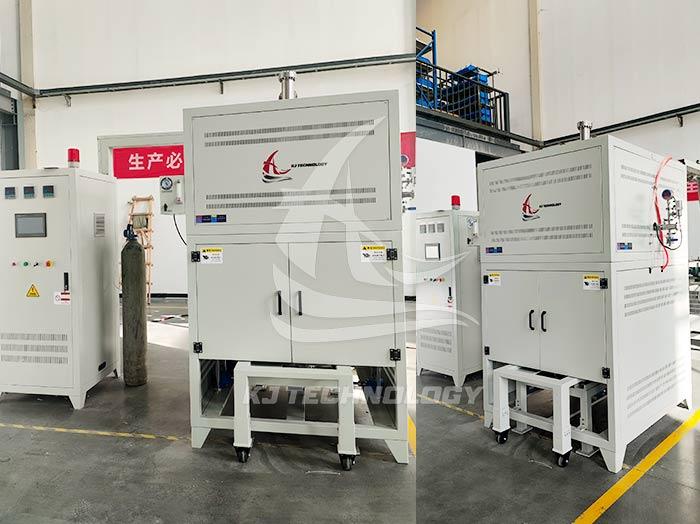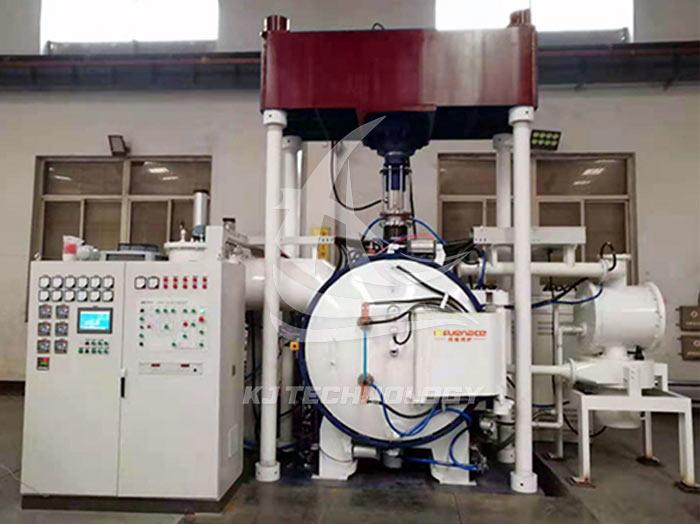High vacuum heat treatment electric furnace for metal heat treatment
 09-26-2025 Author: KJ technology
09-26-2025 Author: KJ technology
High vacuum heat treatment electric furnaces have shown significant advantages in metal heat treatment. They eliminate reactive gases such as oxygen in a vacuum environment, effectively suppressing adverse reactions such as oxidation, decarburization, and carbonization, while optimizing material properties. The following is a specific analysis:
1. Core advantages
No oxidation, no decarburization: In a vacuum environment, no oxide film can form on the metal surface, avoiding material loss. For example, the surface smoothness of high-speed steel cutting tools is improved by more than 30% after heat treatment. At the same time, when carbon steel is heated in air, the surface carbon reacts with oxygen to produce CO ₂, resulting in a decrease in hardness, while the thickness of the decarburization layer can be controlled within the set value in a vacuum environment.
Degassing effect: At high temperatures, gas impurities such as hydrogen, oxygen, and nitrogen inside the material will diffuse to the surface and be pumped away by a vacuum pump, reducing defects such as pores and cracks. For example, the fatigue life of titanium alloy forgings is improved after vacuum annealing.
Removing adsorbates: Vacuum environment can remove moisture, oil stains, etc. adsorbed on the surface of materials, improving the quality of subsequent coatings or welding.
High thermal efficiency: There is no convective heat dissipation in a vacuum environment, and the heating efficiency is higher than that of an air furnace.
Non polluting emissions: No need to treat oxide scale or quenching oil smoke, in line with green manufacturing requirements.
2. Typical applications
Aerospace field:
After solution treatment at 1150 ℃ in a vacuum furnace, the grain size of nickel based high-temperature alloy blades is refined and the high-temperature strength is improved.
Titanium alloy forgings are annealed at 800 ℃ in vacuum (10 ⁻⁴ Pa) to eliminate forging stress and avoid surface oxidation, and are used for aircraft landing gear.
In the field of automobile manufacturing:
Gear vacuum carburizing: carburizing at 930 ℃ in low vacuum (500Pa) results in higher surface hardness and improved wear resistance compared to traditional gas carburizing.
Vacuum quenching of mold steel: H13 steel is austenitized at 1020 ℃ in a vacuum furnace and then subjected to high-pressure gas cooling, resulting in better hardness and extended thermal fatigue life.
In the field of electronic manufacturing:
Magnetic material annealing: NdFeB permanent magnets are annealed at 900 ℃ in vacuum (10 ⁻ ³ Pa) to increase coercivity and are used in electric vehicle motors.
Semiconductor material processing: Develop 10 ⁻⁴ Pa ultra-high vacuum furnaces to meet the cleanliness requirements of semiconductor materials such as silicon wafers.
In the field of medical devices:
Stainless steel instrument polishing: After annealing at 1050 ℃ in a vacuum furnace, the surface roughness of 316L stainless steel surgical instruments decreases and no further polishing is required.
Heat treatment of cobalt chromium alloy joint prosthesis: Solution treatment at 1200 ℃ in vacuum (10 ⁻⁴ Pa) to eliminate casting defects and improve biocompatibility.
3. Heating method
The high vacuum heat treatment electric furnace adopts multiple heating methods to meet the heat treatment needs of different metal materials:
Resistance heating: using graphite, molybdenum or nickel chromium alloy resistance heating element, suitable for medium and low temperature treatment below 1200 ℃.
Induction heating: By generating eddy currents in metal workpieces through high-frequency induction coils, rapid heating can be achieved (up to 2000 ℃ or above), suitable for local heating or large workpieces.
Electron beam heating: Using high-energy electron beams to bombard the surface of the workpiece, achieving local heating under ultra-high vacuum (below 10 ⁻⁴ Pa).
4.Cooling method
The high vacuum heat treatment electric furnace is equipped with multiple cooling methods to achieve different heat treatment effects:
Gas cooling: By introducing high-pressure argon or nitrogen gas for forced cooling, the cooling rate is faster and suitable for quenching processes.
Oil/water cooling: Some furnace models are equipped with oil tanks or water jackets, but attention should be paid to vacuum sealing and oil contamination control.
Self cooling: relying on furnace body heat dissipation, suitable for low-temperature annealing or slow cooling processes.








